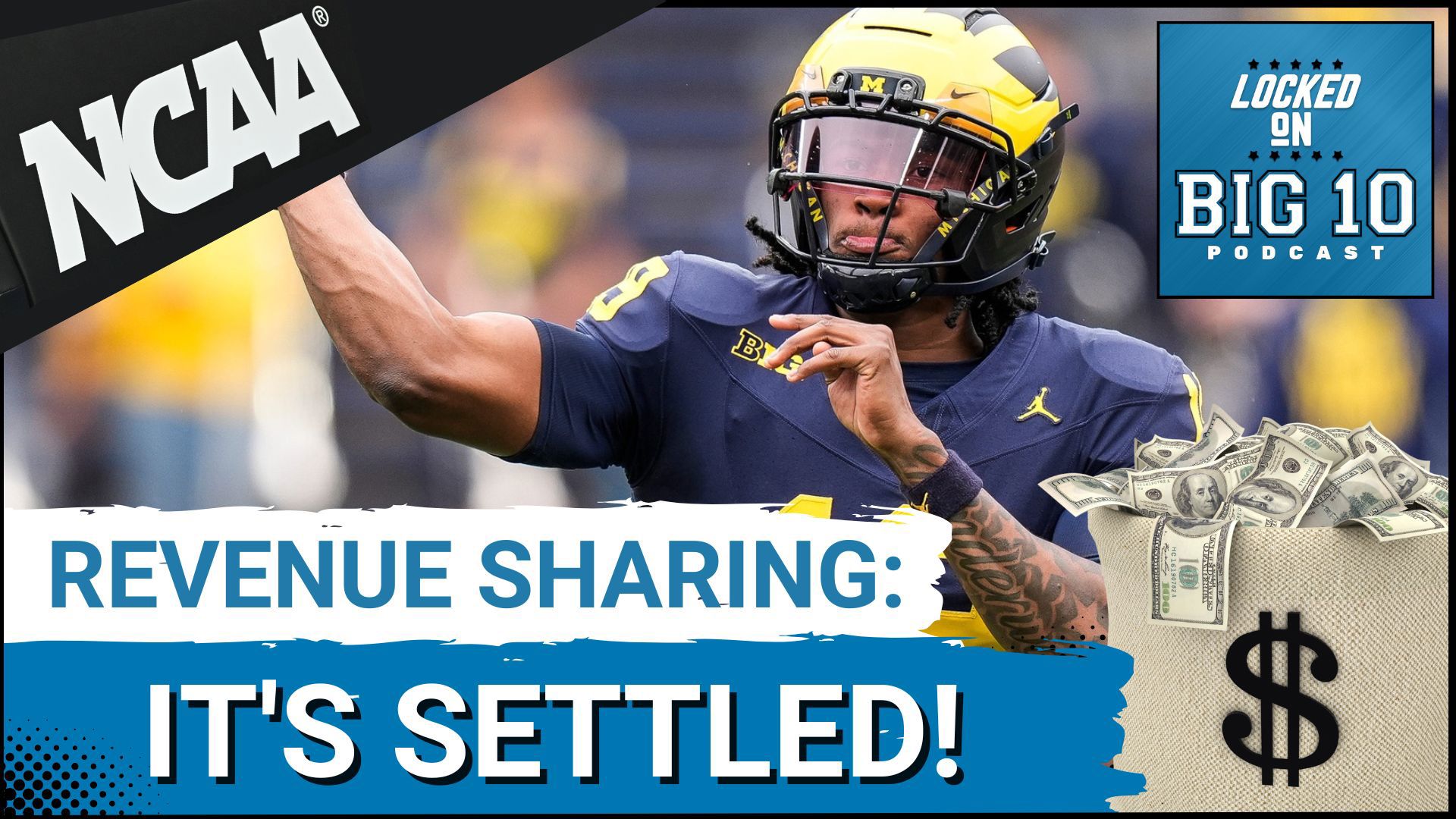NIL
How NCAA settlement could impact small schools, transfer portal

NIL
Kalen DeBoer addresses future at Alabama amid Michigan speculation

Alabama coach Kalen DeBoer ended all speculation Sunday afternoon alluding to potential interest in the Michigan vacancy with the Crimson Tide set to Oklahoma in the first round of the College Football Playoff next week. DeBoer was considered among the best fits for the Wolverines soon after Sherrone Moore’s firing earlier this week.
DeBoer was scheduled to meet with media on Monday, but released a statement ahead of that appearance.
“My family and I are very happy in Tuscaloosa and remain extremely grateful for the support of President Mohler, Greg Byrne, the board and so many others,” DeBoer said through Yea Alabama, the Crimson Tide’s NIL collective. “We have an incredible opportunity in front of us, so my sole focus is on Alabama football and our preparations to play Oklahoma in the College Football Playoff. I have not spoken and have no interest in speaking with anyone else about any other job. I am fully committed to this program and look forward to continuing as the head football coach at the University of Alabama.”
In his second season with the Crimson Tide after taking Washington to the 2023 national championship game, DeBoer is 19-7 at Alabama, which faces Oklahoma in the first round of the College Football Playoff on Friday night.
“We are proud to have Coach DeBoer leading our football program at The University of Alabama,” Crimson Tide athletic director Greg Byrne said in a statement. “He is an incredible coach and does an excellent job with the development of our student-athletes, both on and off the field. Just as he is committed to this team, we are committed to him, and we look forward to taking the field Friday in the first round of the College Football Playoff.”
DeBoer’s statement came after Ryan Williams and other players mentioned rumors on social media being difficult to avoid.
“Yeah, of course we see it on TV, but I mean, he’s gave his best effort here,” Williams said Friday. “Focused on playing against Oklahoma, we’re not really worried about it. … I mean, at the end of the day, he serves us 100% and that’s our coach, so we’re going to play for him. External noise is external noise, so we just focus on the internal.”
This isn’t the first job opening this cycle where DeBoer’s name immediately emerged. DeBoer denied previous speculation about the Penn State vacancy prior to the Nittany Lions’ hiring of Matt Campbell, but had not addressed the Michigan situation until Sunday.
DeBoer and the Crimson Tide’s chief focus can now be on the Sooners after a previous loss to Oklahoma last month put Alabama in several playoff elimination games down the stretch. The Crimson Tide suffered three giveaways during that 23-21 setback in Tuscaloosa despite doubling Oklahoma in total yardage and largely dominating the contest.
The Alabama-Oklahoma winner plays unbeaten and top-seeded Indiana at the Rose Bowl in the quarterfinals.
NIL
College football coach addresses Michigan vacancy after winning bowl game

The college football coaching carousel appeared to be all sewn up, right until Michigan dropped a bombshell with its sudden decision to fire head coach Sherrone Moore, leaving open one of the nation’s most prestigious schools looking for a new man.
Into that conversation, Jedd Fisch has been inserted, both by the oddsmakers and the prediction markets, but predictably not by the man himself.
Although after his Washington Huskies team dominated Boise State in the first bowl game of the postseason, Fisch once again was approached about an opening, and sounded a little different than he has in the past on the subject.
What Fisch said about it
“I’m fully focused on our team,” Fisch, a former assistant coach at Michigan, said about the speculation around the program.
“I think our team worked really hard this whole week, and we all gave everything we had, and we played at a very high level because of that. That’s all I would say on that.”
Those comments do strike a modestly different tone than the more aggressive stance Fisch had earlier in the offseason when he was linked to the Florida vacancy.
“Those lists are made by people that have no idea what’s going on honestly,” Fisch said about those who were reporting on his apparent future plans.
Back then, Fisch, a Florida alum, was reportedly being considered for the Gators’ head coaching position before the school hired Jon Sumrall from Tulane to replace Billy Napier.
What Fisch has done
Fisch is credited with helping rebuild two Power Four programs, winning 10 games at Arizona in 2023 after winning one game the year before, and over two years amassed a 15-11 record at Washington.
Washington finished the 2025 season with an 9-4 overall record, splitting its final six regular season games after starting 5-1, looked impressive in the bowl game, and ranked in the top 25 nationally in scoring with almost 34 points per game.
Fisch has five years remaining on a contract that pays him an average of $7.75 million per year after signing a 7-year, $54.075 million contract last year.
And he has some experience at Michigan, too, serving as the quarterbacks coach, wide receivers coach, and passing coordinator starting in 2015 and lasting through 2017.
What the prediction markets say
Three current head coaches dominate the big board to become the next Michigan head coach, and Fisch still tops that group.
Fisch is in first place with 41 percent odds to take the Wolverines job, according to the latest figures posted to the prediction market Kalshi.
Alabama head coach Kalen DeBoer sits in second with 23 percent likelihood, and Arizona State coach Kenny Dillingham is third at 11 percent.
But while those names are gaining traction in the betting markets, all of them seem to be far-fetched for Michigan to seriously pursue given they all have expressed happiness with where they are.
The search for Michigan to replace Sherrone Moore is on, and time is running tight, with no candidates yet to emerge as a likely candidate.
Read more from College Football HQ
NIL
Ranking and grading all the college football coaching hires this cycle

The college football coaching carousel hasn’t stopped spinning just yet, as almost every hiring at one school creates a fresh opening at another until all the pieces eventually settle into place.
Not to mention that whole situation at Michigan.
But we’re most of the way there, with the Wolverines and Missouri State the remaining FBS schools without a head coach as of Sunday.
Meanwhile, more than two dozen head coaches have been hired in new places.
We rank and grade them all here, but keep in mind grades also pertain to fit.
For example, we’re not saying Eric Morris would have been a better hire than Matt Campbell for Penn State, but Morris was an excellent hire for Oklahoma State for the reasons we’ll outline. And we’re not saying Florida should have hired Brian Hartline over Jon Sumrall, but the Hartline hire was a home run for South Florida, etc. It’s all relative to each school’s unique situation.
But this will surely spark some disagreement and debate, so have at it.

1A. Virginia Tech hires James Franklin — A+
The first head coach hiring this cycle (Nov. 17) also tops our list as the most impactful move overall.
Cite Franklin’s record against top-25 opponents all you want, there’s a preponderance of proof that the man builds winners and elevates the programs he takes over.
Look, if he were hired at Florida or LSU, maybe we’re not putting him atop this list, but Virginia Tech wasn’t going to make a bigger splash than it did in hiring Franklin.
The Hokies haven’t had a top-10 finish since 2009 and had failed twice in trying to find a worthy successor to legendary coach Frank Beamer, ultimately striking out with Justin Fuente (who had four years of experience as a head coach at Memphis) and Brent Pry (who was Franklin’s longtime defensive coordinator at Vanderbilt and Penn State).
They just went from two dice-roll hires to landing a coach with a 128-60 career record at Vanderbilt and Penn State, including back-to-back 9-win seasons with the Commodores when that was still relatively unheard of and six seasons with double-digit wins at Penn State, including a 13-3 College Football Playoff semifinals run last year.
Franklin has already revived Virginia Tech recruiting, rallying the Hokies from 121st in the Rivals recruiting rankings to 27th in a matter of weeks before signing day earlier this month.

1B. Ole Miss hires Lane Kiffin — A+
Take away all the drama that mostly just affects Ole Miss and Kiffin’s personal legacy, and there’s no disputing this was a power move for LSU.
Like him or loathe him, Kiffin is a proven winner on the field.
Ole Miss had two 10-win seasons since the early 1970s before Kiffin arrived and delivered four such seasons in the last five years, including this 11-1 Rebels team now embarking on the College Football Playoff without him.
He had two 10-win seasons in three years at Florida Atlantic before that. He was an elite offensive coordinator at Alabama.
The guy may be a wildcard when it comes to all the drama that seems to follow him on the periphery wherever he goes, but he is a coach capable of winning a national championship in the near future at LSU. There simply aren’t many hires you can say that about.
And then there’s the recruiting element. LSU closed strong before signing day earlier this month to land the No. 11-ranked recruiting class by Rivals, which may well be the lowest the Tigers ever finish under Kiffin.

3. Oklahoma State hires Eric Morris — A+
For all the success Mike Gundy had over a very long time at Oklahoma State, it’s a tough job and wasn’t going to attract a big-name established Power 4 head coach on the rise. Even Gundy candidly admitted the challenges he faced working at a steep NIL disadvantage.
Oklahoma State needed to find a new identity for its program with this hire, one that could rally boosters and recruits alike, and it did that by hiring a proven QB guru who is building a Lincoln Riley-like resume in that regard (without the Heisman — yet).
Morris really started building a name for himself at the FCS level at Incarnate Word, where he brought in an overlooked QB recruit in Cam Ward, put up crazy offensive numbers, and followed Ward to Washington State as offensive coordinator for a year. Ward, of course, went on to become the No. 1 overall draft pick after finishing up at Miami.
Morris, meanwhile, went to North Texas and took over a middling program coming off four straight non-winning seasons. After a slow build the first two years there, he led the Mean Green to 11 wins this season, its first national ranking in the AP poll since 1959 and came one victory shy of making the College Football Playoff.
He did that while turning another overlooked QB recruit, walk-on Drew Mestemaker, into the most prolific passer in the country this year (FBS-best 4,129 passing yards) and leading the FBS in scoring and total offense (44.8 points/504.3 yards per game).
Morris was also the offensive coordinator at Texas Tech when Patrick Mahomes passed for 9,705 yards and 77 TDs over two seasons and is credited with bringing future Heisman Trophy winner Baker Mayfield to Texas Tech as a walk-on (before he transferred to play for Riley at Oklahoma), as well as signing John Mateer at Washington State.
It’s hard to imagine Oklahoma State could have made a more impactful hire to revive enthusiasm for what’s possible again in Stillwater.

4. Penn State hires Matt Campbell — A
Penn State had more time than any other big-time program to hone in on and land a head coach, and the Nittany Lions were attached to many other names along the way to getting to Matt Campbell, including the failed push to pry Kalani Sitake out of Provo.
So maybe Campbell wasn’t Penn State’s first choice, or the fans’ first choice, and the rash reaction has been to hammer athletic director Pat Kraft for the optics of what unfolded.
The fact remains Matt Campbell is a very, very good football coach who has deserved a chance to prove that in a more high-profile job after essentially changing the entire perspective of what was possible at Iowa State.
Iowa State won 3, 2 and 3 games in the three seasons before Campbell was hired and had just one winning season overall (7-6) in the 10 years before he landed in Ames. In his 10 seasons there, the Cyclones went 72-55 with eight winning seasons in the last nine years.
Everything is relative. Campbell took on one of the hardest jobs in college football and excelled.
Among his highlights were a 9-3 finish, a Fiesta Bowl win and a No. 9 final AP ranking in 2020 and an 11-3 mark and No. 15 finish in the polls last year.
He was in the mix for the USC job before Lincoln Riley got it four years ago, and it was only a matter of time until a big-name program hired him. This is not a reach for Penn State — this is a nice get.
The only knock on Campbell is that he’s not the most dynamic personality, and that is important in recruiting, but nowadays recruiting is so much about a program’s recruiting department, collective and NIL offerings.
If Penn State supports Campbell on the recruiting side, he’ll deliver on the field.

5. Michigan State hires Pat Fitzgerald — A
Michigan State needed to nail this hire and bring some stability to a program that endured the ugly ending to Mel Tucker’s tenure two games into his fourth season (fired for cause for off-the-field matters) and Jonathan Smith’s disappointing two-year run as head coach.
How about a coach who stayed at Northwestern for 17 years despite plenty of opportunities to leave?
Like Campbell, Fitzgerald made a reputation as an overachiever at a school that is not traditionally an easy place to win in college football.
Fitzgerald went 110-101 with the Wildcats, posting three 10-win seasons, two 9-win seasons and was named the Bobby Dodd Coach of the Year after leading the Wildcats to a 7-2 mark and a Big Ten championship game appearance in the COVID-shortened 2020 season.
He was fired in July 2023 after an investigation into hazing allegations among players within the program, but he filed a wrongful termination lawsuit that ended in a settlement this summer, and Northwestern issued a statement saying it did not believe Fitzgerald was ever made aware of the hazing complaints. He said he felt “vindicated” by the outcome and was ready to resume his coaching career.
If some schools were cautious about him as a result, that was Michigan State’s gain as it landed a proven Big Ten winner.

6. Utah promotes Morgan Scalley — A
It was expected that longtime Utah coach Kyle Whittingham would call it quits after this season, and he indeed made that announcement this week, with the Utes subsequently naming longtime defensive coordinator Morgan Scalley as his full-time replacement.
That too was expected, as Scalley had been acknowledged as the coach in waiting.
Scalley played at Utah from 2001-04, joined the staff in 2007 as a GA and has been the Utes’ defensive coordinator for the last 11 seasons under Whittingham.
The program has been consistently successful and always defined by his physical defensive prowess, so turning the reins over to Scalley is the absolute right move here.

7. South Florida hires Brian Hartline — A
South Florida lost coveted rising coach Alex Golesh to Auburn and replaced him with perhaps an even more intriguing rising young coach.
Hartline, a former Ohio State and NFL wide receiver, has established himself as one of the top recruiters in college football during his time with the Buckeyes, ultimately rising up to the role of offensive coordinator for the No. 2-ranked team entering the College Football Playoff.
He’s credited with recruiting and developing NFL receivers Chris Olave, Garrett Wilson, Jaxon Smith-Njigba, Marvin Harrison Jr., Emeka Egbuka and eventually, next year, Jeremiah Smith.
Hartline should be able to keep South Florida’s roster loaded with talent, and now gets the chance to prove what he can do as a head coach.

8. Florida hires Jon Sumrall — B+
Florida came up short in the Lane Kiffin sweepstakes and seemed to quickly hone in on Sumrall, Tulane’s fast-climbing head coach, as its next preferred target.
It is mildly interesting that Florida chose to roll the dice on another young Group of Five head coach after Billy Napier’s failed tenure, but if there was one to bet on, it’s Sumrall.
The 43-year-old has won at least nine games in all four seasons he’s been a head coach, going 43-11 over two seasons at Troy and two at Tulane (including 11-2 with an AAC championship and CFP berth this year).

9. Kentucky hires Will Stein — B+
This is a case where fit factors in majorly. Kentucky is one of the toughest jobs in the SEC, and finding someone who has a personal attachment and heightened investment in the program means a lot.
Especially when that someone is also a highly-successful offensive coordinator for a playoff team.
Stein, 36, grew up in the state of Kentucky and played at Louisville, but his parents went to Kentucky, and he grew up a Wildcats fan.
The offensive coordinator at Oregon for the last three years, Stein’s Ducks rank ninth nationally in scoring at 38.2 points per game and 13th in total offense (465.2 yards per game). Oregon finished second nationally in total offense and scoring in 2023 with Bo Nix at QB and 22nd/17th last year.
Stein should bring fresh energy to Kentucky and be able to sell recruits and boosters on his offensive upside.

10. UCLA hires Bob Chesney — B+
Well, we can’t expect history to totally repeat itself after the last James Madison coach to leave for a Big Ten job was Curt Cignetti for Indiana. That’s the 99.9999999th percentile of coaching hires.
But even without that context, UCLA did well to land a coach in Chesney who has worked his way up the ranks, succeeding at every stop. He was the head coach at Division III Salve Regina for three years (23-9), then five years at Division II Assumption (44-16) and six seasons at FCS Holy Cross (44-21) before going 21-5 the last two years at James Madison, including this 12-1 team that crashed the CFP party.
11. Colorado State hires Jim Mora — B+
This one may have flown under the radar for a lot of college football fans, but Colorado State pulled a bit of a coup in getting Mora to make basically a lateral move from UConn, where he posted back-to-back nine-win seasons.
Mora, of course, has been an NFL head coach with the Atlanta Falcons and coached UCLA for six years, including a pair of 10-win seasons.
Colorado State has had just one winning season in the last eight years and bottomed out at 2-10 this year, prompting the firing of Jay Norvell midseason. Mora is a massive upgrade for the Rams.
12. Memphis hires Charles Huff — B+
Memphis should be one of the most desirable G5 jobs in the country, given that its last three head coaches (Justin Fuente, Mike Norvell and Ryan Silverfield) all parlayed their tenures there into P4 head coaching jobs.
That’s why Huff bolted Southern Miss after one year. He took over a 1-11 Southern Miss program and went 7-5 in his lone season there, after previously posting a 32-20 mark over four seasons as head coach at Marshall, including a Sun Belt championship last year.
13. UConn hires Jason Candle — B
UConn was surprised when coach Jim Mora left after back-to-back nine-win seasons to take a comparable job at Colorado State, but the Huskies recovered well.
Candle went 81-44 over 10 seasons at Toledo, where he replaced Campbell after previously serving as offensive coordinator there. He never had a losing season at Toledo, posting two 11-win campaigns in 2017 and 2023, and winning two MAC championships.
14. North Texas hires Neal Brown — B
North Texas got a taste of big-time football this year, winning 11 games and staying in the CFP hunt all the way until its AAC championship game loss to Tulane. The Mean Green wanted to keep Morris, but that wasn’t going to happen.
So it makes sense they preferred a veteran head coach to come in and try to keep the program humming amidst its now heightened expectations.
Brown struggled as head coach at West Virginia, going 37-35 over six seasons while winning more than six games in only one of those campaigns, but he was the big G5 name before that after leading Troy to three straight double-digit-win seasons. This makes sense all around.
15. Cal hires Tosh Lupoi — B
Cal badly needed a jolt of fresh energy after the stale Justin Wilcox tenure, and Lupoi should provide that, coming off a successful four-year run as Oregon’s defensive coordinator.
It’s also important that this isn’t just any job for him. Lupoi is from Walnut Creek, California, played for the Golden Bears from 2000-05, and launched his coaching career with the program as its defensive line coach from 2008-11.
Lupoi’s Oregon defenses improved throughout his tenure (albeit under defensive-minded head coach Dan Lanning), finishing 71st nationally in total defense in 2022 and then 22nd, 15th and 3rd this season (allowing just 251.6 yards per game).
16. Iowa State hires Jimmy Rogers — B
Rogers wasn’t an instant success at Washington State, going 6-6 in his lone season there, but before that, he was one of the most successful FCS head coaches and deserved a shot to prove himself at the FBS level.
He went 27-3 in two seasons at his alma mater, South Dakota State, including a 15-0 FCS national championship season in 2023, after working his way up the staff there since 2013, getting promoted to defensive coordinator before taking over as head coach.
He should fit the ethos of Iowa State’s program that was established under Campbell.
17. Oregon State hires JaMarcus Shephard — B-
You might be asking, who is JaMarcus Shephard and why is he so high on this list? Understandable.
But also understand that Oregon State is one of the toughest jobs in the FBS now that it’s no longer in a P4 conference and doesn’t appear well-situated for the NIL/revenue-sharing era of roster building. So the Beavers weren’t going to have any high-profile options here short of hiring a retread.
Shephard brings energy and a reputation as a good recruiter to the job. Alabama’s co-offensive coordinator the last two seasons under Kalen DeBoer, he got his start at Western Kentucky in a variety of roles from 2011-16, became the passing game coordinator at Purdue in 2017 and then the Boilermakers’ co-OC from 2018-21, and was the passing game coordinator and WRs coach at Washington under DeBoer from 2022-23 before following him to Tuscaloosa.
This is where we reiterate that the grades and rankings are about fit and how each school did in maximizing its needs with its hire. We’re not saying Shephard is a better coach than some of the names to follow on this list; we’re saying he was a smart move for Oregon State, given its constraints.
18. Auburn hires Alex Golesh — B-
Golesh had as much buzz as any G5 coach this cycle aside from maybe Sumrall, and he was going to land a big job somewhere, so this was a sensible landing spot.
But for all that buzz, Golesh’s resume isn’t exactly overwhelming. He went 7-6 in his first two seasons at South Florida, then 9-3 this year, notably beating Boise State and Florida to climb into the national rankings, and later North Texas. But the Bulls squandered opportunities to push for a playoff berth with losses to Memphis and Navy. In the end, it felt like an underwhelming season given the early hype.
19. Toledo hires Mike Jacobs — B-
There wasn’t much spotlight on the Toledo coaching search, but the Rockets quietly made an intriguing hire here after losing longtime head coach Jason Candle to UConn.
Jacobs just went 20-6 in two seasons at FCS-level Mercer, making the playoffs both years while going 15-1 in the Southern Conference after also succeeding at the Division II level for four years each at Notre Dame College (42-8) and Lenoir-Rhyne (32-9), leading each to the Division II semifinals.
20. James Madison hires Billy Napier — B-
This feels a little like when Georgia Southern hired Clay Helton after his failed tenure at USC, landing a big name on the rebound. The difference is that before floundering at Florida, Napier was a successful Sun Belt coach, going 40-12 over four seasons at Louisiana.
But James Madison struck gold in consecutive hirings by landing hungry coaches climbing the career ladder in Curt Cignetti (before his Indiana fame) and Bob Chesney (now at UCLA). It will be interesting to see how Napier bounces back from his struggles in the SEC (22-23 at Florida).
21. Southern Miss promotes Blake Anderson — B-
Southern Miss enjoyed a bounce-back season this year under Charles Huff, going 7-5 after winning four games combined the previous two years, so it’s not a surprise the program opted for continuity when Huff left after one season for Memphis.
Anderson was the offensive coordinator at Southern Miss this year, but he also has considerable head coaching experience. He was 51-37 in seven seasons at Arkansas State with two Sun Belt championships and 23-17 in three years at Utah State, where he delivered an 11-win season and Mountain West championship, followed by two 6-7 finishes.
22. Ole Miss promotes Pete Golding — C+
Obviously, this was an unusual situation all around: Kiffin leaving for LSU, and Ole Miss’ administration being adamant that he couldn’t coach the team in the playoff, promptly promoting Golding to not just interim head coach but full-fledged head coach.
If Ole Miss wasn’t in the playoffs and prioritizing continuity, would Golding have gotten the job? Maybe, maybe not.
He has been a defensive coordinator at UTSA (2016-17), Alabama (2018-22) and Ole Miss (2023-25), and his Rebels defenses have ranked 14th nationally last season (311.2 YPG) and 33rd this year (333.1 YPG).
23. Kansas State hires Collin Klein — C+
It’s debatable what was more surprising — Chris Klieman’s immediate retirement or Kansas State turning to a former star quarterback to take over the program.
On the one hand, it’s an exciting hire for fans and boosters, which is ever-important these days, as Klein was a Heisman Trophy finalist for the Wildcats in 2012 and is tied to the Bill Snyder Era.
On the other hand, it’s questionable if any other P4 programs would have considered Klein for a head coaching position at this point. He started his coaching career at K-State as a graduate assistant in 2014-15 and returned from 2017-23 first as QBs coach and later offensive coordinator before moving on to Texas A&M, where he has been OC the last two seasons and helped the Aggies to their 11-1 mark this year with an offense that ranks top-20 in yards and points.
24. Coastal Carolina hires Ryan Beard — C+
Cue up the Ted Lasso “Coach Beard” memes!
This is an intriguing hire to a degree, as Beard coached competitive teams at Missouri State and led that program through its transition from FCS to FBS, going 7-5 this year in the Bears’ first official season in Conference USA. Beard was 19-16 overall in three seasons as head coach after being promoted from defensive coordinator.
That’s all well and good, but Coastal Carolina should be a more appealing job. Jamey Chadwell won 31 games over his final three seasons there before leaving for Liberty. Tim Beck couldn’t sustain that success, but it’s a desirable job with a recruiting advantage, being next to the tourist draw of Myrtle Beach, South Carolina.
It feels like Coastal Carolina could have made a bigger splash here, but that doesn’t mean Beard won’t work out.
25. Arkansas hires Ryan Silverfield — C
Four AAC coaches landed P4 head coaching jobs this cycle, and Silverfield would rank last on that list for us, so essentially, Arkansas, an SEC program, hired the fourth-best AAC coach.
Maybe we’re being harsh, but keep in mind that every coach at Memphis for a while now has had a certain base level of success before moving on to a bigger job. Justin Fuente parlayed his Tigers run into a failed tenure at Virginia Tech, and then Mike Norvell rode Memphis into the Florida State job, which isn’t going well at the moment.
Silverfield arguably had less success than either of them. He was 50-25 in seven seasons at Memphis, including a 10-3 mark in 2023 and 11-2 in 2024, before an 8-4 finish this year, notably including a 32-31 win over Arkansas. Perhaps that game resonated with athletic director Hunter Yurachek, but the Tigers lost most of their biggest games this year to fall out of the AAC race.
26. Washington State hires Kirby Moore — C
Washington State is in a tough spot in the new landscape of college football, losing its P4 status while getting left behind in conference realignment after the old Pac-12’s implosion. As a result, Jake Dickert bolted for Wake Forest, and his replacement, Jimmy Rogers, lasted only one season before leaving for Iowa State.
So we’re not saying this hire doesn’t make some sense. Moore is from Prosser, Washington, which is less than three hours from Pullman, so he may feel an additional personal stake in leading this program, which is important.
But his experience is as an offensive coordinator at Fresno State for a season, followed by the last three at Missouri under offensive-minded head coach Eliah Drinkwitz.
27. Stanford hires Tavita Pritchard — C-
Andrew Luck’s tenure as Stanford general manager has been an interesting one so far, from firing Troy Taylor last March for off-the-field issues regarding his treatment of staff, to appointing Frank Reich (his head coach for a year with the Indianapolis Colts) as interim coach for the 2025 season, and now hiring another familiar face.
Pritchard was Stanford’s starting QB in 2008 before Luck claimed the job the next year, and the two have remained close. Pritchard was Stanford’s coaching staff from 2010-22, starting as a graduate assistant and rising up to offensive coordinator. He was the Washington Commanders’ quarterbacks coach for the last three seasons.
It’s unlikely Pritchard was being looked at for any other P4 head coaching job.
28. Tulane promotes Will Hall — C-
Tulane opted for continuity in replacing Sumrall, promoting its offensive coordinator Hall, who now gets a second chance to prove himself as an FBS head coach.
Before returning to Tulane this year (after previously serving as offensive coordinator in 2019-20), Hall was the head coach at Southern Miss from 2021-24, going 14-30. He was previously the head coach at Division II West Alabama (25-11 in three seasons) and West Georgia (31-9 in three seasons, including two DII semifinal appearances).
Our main criticism here is that this job has become a launching pad for P4 opportunities, with Willie Fritz going on to Houston and Sumrall to Florida, so surely it was an attractive job for coaches looking to climb the ladder. Hall doesn’t move the needle externally, but Tulane’s decision-makers know him better than anyone and are convinced this was the best move, so we’ll give them the benefit of the doubt.
29. UAB hires Alex Mortensen — C-
This feels like UAB didn’t really have a plan. Mortensen, the son of late ESPN NFL reporter Chris Mortensen, took over as interim coach midway through this season after Trent Dilfer was fired following a 9-21 tenure.
Mortensen went 2-4 the rest of the way with an upset win over Memphis in his first game as head coach. He did gain valuable experience in two stints on staff at Alabama as a GA/analyst, from 2014-19 and 2020-22, before becoming OC at UAB in 2023. His offenses ranked 18th, 58th and 54th nationally with the Blazers.
NIL
Kalen DeBoer: ‘No interest’ in talking to other schools, leaving Alabama
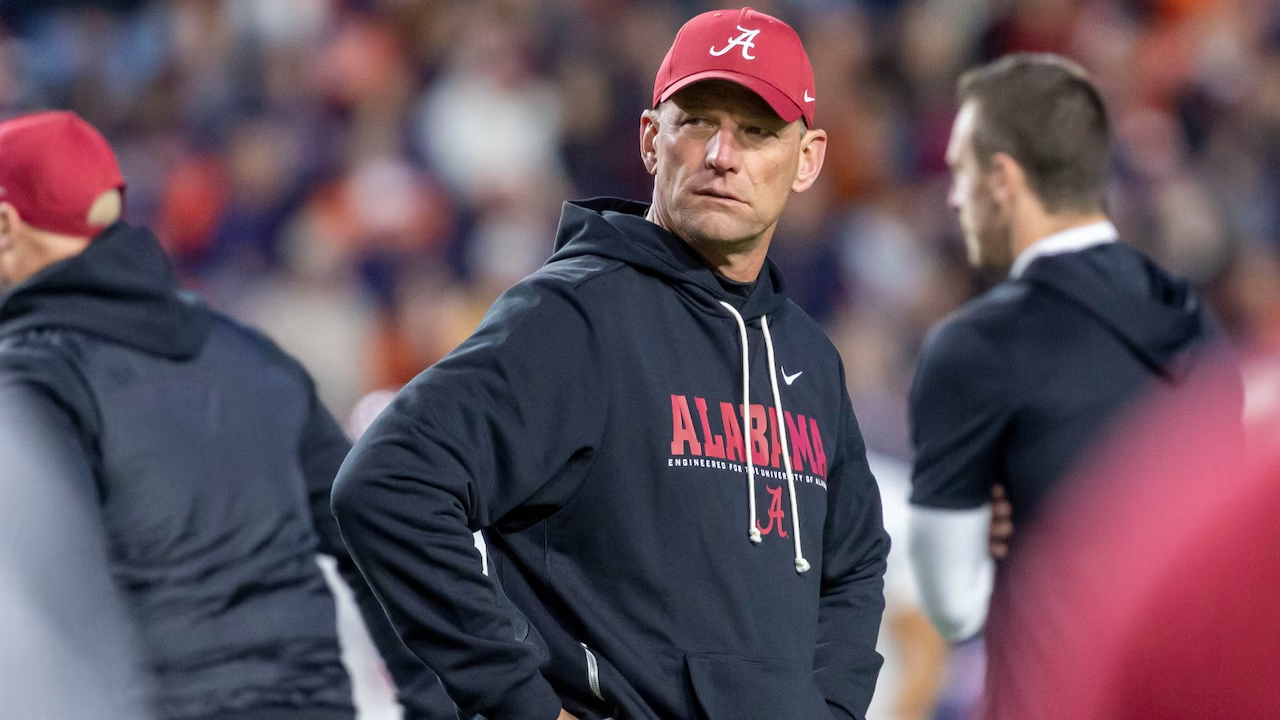
If you take Kalen DeBoer at his word, he has no interest in leaving Alabama.
As speculation runs wild about Michigan’s potential interest in DeBoer, the Crimson Tide head coach issued a written statement Sunday declaring he and his family “very happy in Tuscaloosa” and “grateful for the support.”
“We have an incredible opportunity in front of us, so my sole focus is on Alabama football and our preparations to play Oklahoma in the College Football Playoff,” the statement, issued through Alabama’s NIL collective, Yea Alabama, read.
Alabama secured the No. 9 seed in the CFP with a 10-3 season and berth in the SEC championship game, drawing Oklahoma in Friday night’s first-round game in Norman (8 p.m., ABC/ESPN).
But losses to Florida State, Oklahoma and Georgia had the Tide on the bubble when it came selection time, following a 9-4 season that kept Alabama out of the CFP in 2024.
And that’s the sticking point in Tuscaloosa. Prior to DeBoer’s arrival, Nick Saban had taken Alabama to four straight playoffs and nine national title games dating back to 2009.
Meanwhile, Michigan is suddenly looking for a head coach after a chaotic week in Ann Arbor that saw Sherrone Moore abruptly fired Wednesday after two seasons. Moore, 39, was accused of violating school policy after engaging in an inappropriate relationship with a female staffer.
He was then arrested later that day following an incident at the staffer’s residence, jailed and charged with third-degree home invasion, stalking and entering the home.
Arizona State’s Kenny Dillingham is believed to be a target, with Dillingham even addressing the Michigan talk Saturday in Tempe, as is DeBoer, a former assistant at nearby Eastern Michigan from 2014 to ‘16 and offensive coordinator at Indiana.
“I have not spoken and have no interest in speaking with anyone else about any other job,” DeBoer said in the statement. “I am fully committed to this program and look forward to continuing as the head football coach at the University of Alabama.”
DeBoer worked directly with quarterback Michael Penix at Indiana and Washington, where the duo led the Huskies to the national title game in 2023 against Michigan. He would take the Alabama job following Nick Saban’s retirement in 2024, while Michigan replaced the departed Jim Harbaugh with Moore, an up-and-coming assistant with Harbaugh’s endorsement.
Michigan’s coaching search coincides with an active investigation into the athletic department and its culture, with Moore’s actions just the latest in a long list of public relations blunders for director Warde Manuel.
DeBoer is in the second year of his eight-year, $87 million contract he inked with Alabama in 2024, averaging more than $10 million per year. His buyout is only $4 million, making it relatively affordable for another school to pluck him away.
In a coinciding statement, Alabama athletic director Greg Byrne said the school is “proud to have Coach DeBoer leading our football program at the University of Alabama. He is an incredible coach and does an excellent job with the development of our student-athletes, on and off the field.”
Byrne added: “Just as he is committed to this team, we are committed to him, and we look forward to taking the field Friday in the first round of the College Football Playoff.
NIL
College Football Is Beyond Cooked With This Latest NIL Trend

Who saw this one coming? Oh that’s right, EVERYONE!
The slow death of college football as it has been constructed for the past century will be studied someday.
The veil of amateurism has been completely lifted with the advent of NIL and the transfer portal where players can just shill themselves out to the highest bidder.
READ: NIL Lawyer Outlines Lasting Effects Of Sherrone Moore Debacle.
The latest trend might be the worst of them all, though, as we are practically treating college athletes like NFL veterans at this point.
I’m referring, of course, to programs and reporters alike announcing players “re-signing” at their current school.
Allow me to insert my obligatory “what happened to the game I love” before I go any further.
Players are out here acting like free agents in the NFL. What are we even doing here?
Let’s just go ahead and rip that Band-Aid off and stop treating these players like amateur student-athletes, because this is just the latest “point of no return” for the old days of college football.
If you were to take a time machine back, even ten years ago, and tell a fan that players would be getting social media graphics made to announce they’ve signed a contract to remain at their current school, they’d probably throw themselves out the window.
The sentiment is virtually identical, as even modern fans see the ridiculousness in all of this.
It’s a sad state of affairs for anyone who considers themselves a college football traditionalist, as I’m sure even the staunchest defenders of NIL at its inception didn’t have something like this in mind.
Remember when this was just supposed to be so players could make money off the field without having the commies at the NCAA come down on them with an iron fist?
Now, some of these players are making more money than players on their rookie contracts in the NFL.
I’m all for the players getting a slice of the pie, but if this is what we are moving towards, why do we even have academic standards as it is?
As a wise man once said, “We ain’t come here to play school.”
That was ten years ago, and Cardale Jones sounds like a prophet now.
We are hurtling towards a junior league for the NFL, though I fear we have already gone too far to reverse course now.
NIL
CBS Sports ranks Top-25 transfer players in College Football Playoff

One aspect of the offseason that affects teams and contenders every single year now is the NCAA Transfer Portal. Now, ahead of the College Football Playoff, we can see how some of those additions panned out for programs that made the field based on a recent ranking done by those at CBS Sports.
In an article from Friday, CBS Sports rated the Top-25 transfers across the dozen teams who will be in the CFP. Of them all, Oregon led the way with four names on this list, which tracks as they finished fourth last offseason in On3’s 2025 Team Transfer Portal Rankings. Five other teams then had three apiece, with all of them finishing in the Top-20, including two in the top-five and the one who was ranked as the best portal class in the nation, per that same rating from On3.
And, of the fifteen of them who transferred this last offseason, eleven of them were in the Top-100, including six who were in the Top-10, of On3’s Industry Ranking of 2025’s Top Transfer Portal Players. Ten were then in the Top-10 of their respective position, four of those being the top overall player at their position, in that rating from On3.
Needless to say, players like these are what make this next part of the year so important, with the one-time portal window set to open on January 2nd. Before we get to that part of the calendar, though, let’s take a look at these past transfers who could end up helping a team win a national title this season, as rated by CBS Sports:
Even in two days of hindsight, this ranking at number one looks even more spot on. That’s as, as of last night, Mendoza, the quarterback of the top-seeded team in the country in the Hoosiers, won the Heisman Trophy, as the first winner of the award in program history up in Bloomington.
A transfer from California, who was the No. 12 overall player and the No. 4 QB in the portal per On3, in his first season with IU, Mendoza has been one of the best quarterbacks in the country with a career season at 71.5% completion for 2,980 yards, a national best of 33 touchdowns, and six interceptions, while also rushing for 240 yards and six more scores. Now, after leading them to an undefeated record and a Big Ten Championship, and after hosting the Heisman last night in NYC, Mendoza will lead Indiana, the No. 1 overall seed, into the field in hopes of making more history in the CFP.
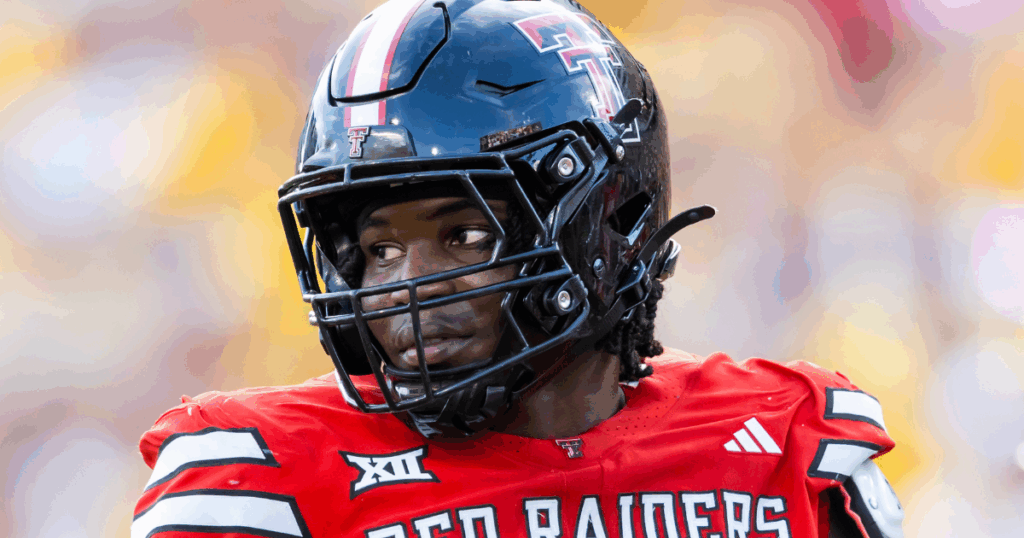
Texas Tech, which had the No. 1 overall class in the portal per On3, had three names on this list just from their defense. Bailey leads that, after being a top-ten overall transfer and the second-best defensive end in the portal at On3, with what he did this season in Lubbock.
Transferring in from Stanford, Bailey had a career-best season with 43 total tackles, with 17.5 being for loss with 13.5 sacks, three forced fumbles with one recovery, and a deflection for the Red Raiders. Production like that is a big part of Texas Tech, with them posting a top-five overall defense, having the best season in school history at 12-1, winning the Big 12 Championship, and making their debut in the CFP.
Downs has been impactful at Ohio State since his transfer two offseasons ago from Alabama. He now may be part of a national title winner, with the Buckeyes having a chance to go back-to-back in the College Football Playoff.
As an anchor on the backend of their defense, being one of the best players in all of college football, Downs, who received Heisman votes as a safety as well as won the Thorpe Award, has had 60 more tackles, 5.0 being for loss with one sack, with two interceptions and two deflections. That has been part of what has led the top overall defense in the country this season, as Ohio State enters as just a one-loss team to be the No. 2 overall seed in the CFP.
Sayin did the exact same thing as Downs, as he transferred two offseasons ago from Alabama, after signing there before the retirement of Nick Saban, to Ohio State. This was his first season as the starter, though, and it has been quite the year he had in Columbus.
Sayin posted a national best in completion rate, and one of the highest all-time, at 78.4% en route to 3,323 yards, 31 touchdowns, and six interceptions for the Buckeyes, which also had him as a finalist last night for the Heisman Trophy. Now, on one of the best teams in the country, Sayin will attempt to lead Ohio State to a second consecutive national title in the College Football Playoff.
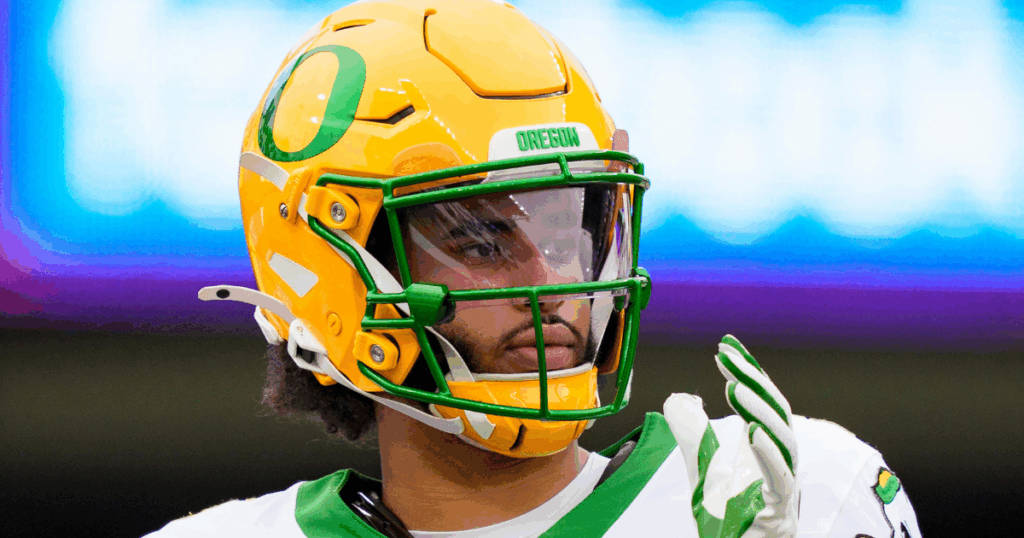
After starting as a freshman at UCLA, Moore transferred two offseasons ago and sat as the backup last year at Oregon. Now, a year later as the starter, that decision has paid off with what he did in Eugene, as he rounds out the top-five here for CBS.
Moore posted 72.5% completion for 2,733 yards, 24 touchdowns, and six interceptions for a top-fifteen offense this season for the Ducks. He’ll now lead Oregon, in a very favorable position as the first of the non-bye teams at No. 5 overall, into what could be run of retribution for them after what happened last year in the CFP.
Texas A&M was one of the best defenses in the nation this year when it came to pressures and tackles for loss. Howell was then the biggest part of that effort in what was his second season in College Station after originally transferring from Bowling Green.
Howell posted the best campaign of his career this year with the Aggies with 29 tackles, 14.0 of those being for loss with 11.5 sacks, along with six deflections and one forced fumble. He’ll now look to continue wreaking the same havoc in the playoff, with A&M set to open up with a home game at Kyle Field.
After the first two weeks of the season, one name that wasn’t expected to be on a list like this would be Chambliss. However, with the play as well as an injury to QB Austin Simmons, Chambliss took full advantage of the opportunity that came his way this year in Oxford after transferring to be a backup from out of Ferris State (DII)
Chambliss, a Top-40 QB in the portal last offseason per On3, went on to post a total of 290.5 total yards per game and 24 touchdowns overall, with 3,016 yards and 18 touchdowns coming as a passer at 65.5% completion, for the Rebels. He’ll now look to keep their offense humming, despite the coaching changes the past two weeks, in what’ll be their debut appearance in the playoff in the ‘Sip.
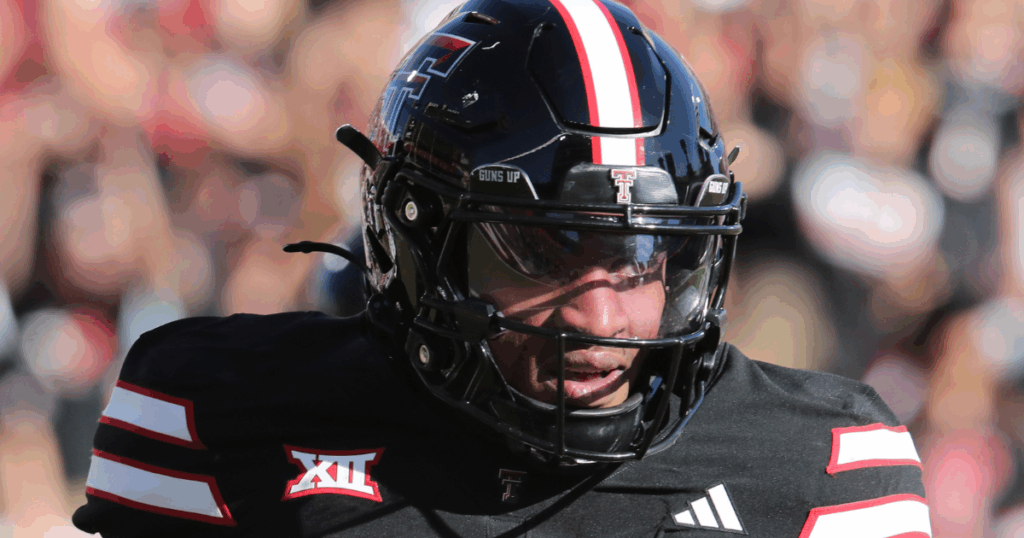
Going back to the defense for the Red Raiders, Height is another defensive end that’s had a great first season in Lubbock. That’s after transferring in last offseason, after being a top-fifty player in the portal and in the top-ten among edges at On3, from Georgia Tech, after beginning his career with two seasons apiece at USC and Auburn.
On that same unit, Height posted some career-best numbers of 33 total tackles, 10.5 being for loss with 9.0 sacks, to go with two forced fumbles, with a recovery, as well as a deflection. That has two pass rushers in the top-ten here at CBS for Texas Tech, who hopes to see both keep causing those kinds of problems for their eventual opponents in the CFP.
Oregon was seen to have one of the better offensive lines in the country this season. A major piece of that was Pregnon, who was a top-thirty overall transfer and the second-best interior lineman after two seasons apiece at USC as well as Wyoming.
Pregnon did not allow a sack this season as part of that line. And, behind him, the Ducks had a top-fifteen total offense at 38.2 points and 246.8 yards per game, with them hoping to have the same output in this appearance in the CFP.
Concepcion was already one of the better wide receivers in college football after his first stop with two years spent at NC State. He then, after being a top-ten overall transfer and the second-best receiver in the portal per On3, was even better this fall for Texas A&M.
Concepcion was the leading pass catcher for the Aggies this season with 57 receptions for 886 yards, averaging 73.8 per game and 15.5 a catch, and nine touchdowns. He, along with their second-leading receiver not too much further down this ranking, will now try to be just as explosive in the pass game as A&M prepares to debut in the College Football Playoff.
11. Miami DE Akheem Mesidor
12. Ole Miss RB Kewan Lacy
13. Texas Tech DT Lee Hunter
14. Oregon DB Dillon Thieneman
15. Oregon OT Isaiah World
16. Indiana LB Aiden Fisher
17. Miami DB Jakobe Thomas
18. Texas A&M WR Mario Craver
19. Georgia WR Zachariah Branch
20. Miami QB Carson Beck
21. Alabama WR Germie Bernard
22. Ohio State CB Davison Igbinosun
23. Oklahoma WR Isaiah Sategna
24. Indiana CB D’Angelo Ponds
25. Tulane QB Jake Retzlaff
-

 Rec Sports3 weeks ago
Rec Sports3 weeks agoFargo girl, 13, dies after collapsing during school basketball game – Grand Forks Herald
-

 Motorsports3 weeks ago
Motorsports3 weeks agoCPG Brands Like Allegra Are Betting on F1 for the First Time
-
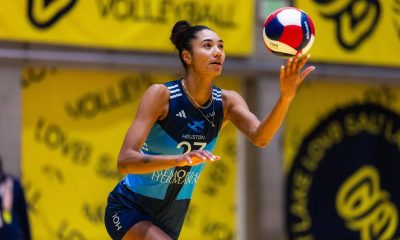
 Sports3 weeks ago
Sports3 weeks agoTwo Pro Volleyball Leagues Serve Up Plans for Minnesota Teams
-

 Sports3 weeks ago
Sports3 weeks agoUtah State Announces 2025-26 Indoor Track & Field Schedule
-
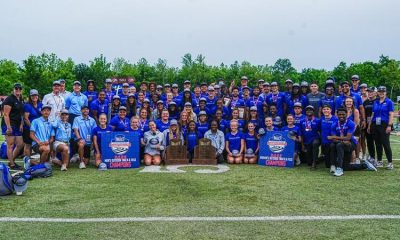
 Sports3 weeks ago
Sports3 weeks agoSycamores unveil 2026 track and field schedule
-
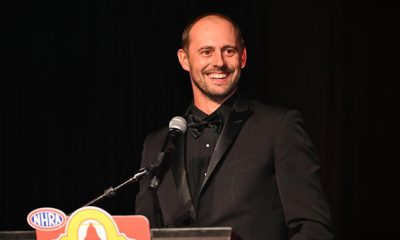
 Motorsports3 weeks ago
Motorsports3 weeks agoRedemption Means First Pro Stock World Championship for Dallas Glenn
-
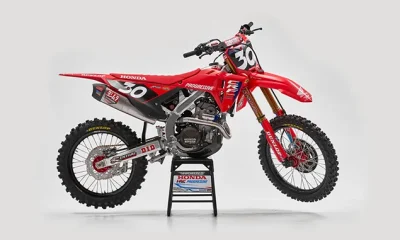
 Motorsports2 weeks ago
Motorsports2 weeks agoJo Shimoda Undergoes Back Surgery
-

 Sports3 weeks ago
Sports3 weeks agoTexas volleyball vs Kentucky game score: Live SEC tournament updates
-
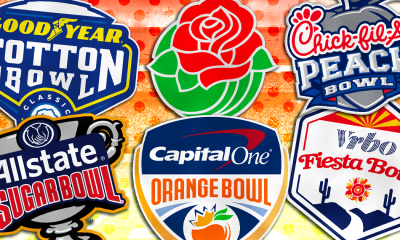
 NIL2 weeks ago
NIL2 weeks agoBowl Projections: ESPN predicts 12-team College Football Playoff bracket, full bowl slate after Week 14
-

 Rec Sports2 weeks ago
Rec Sports2 weeks agoHow this startup (and a KC sports icon) turned young players into card-carrying legends overnight

